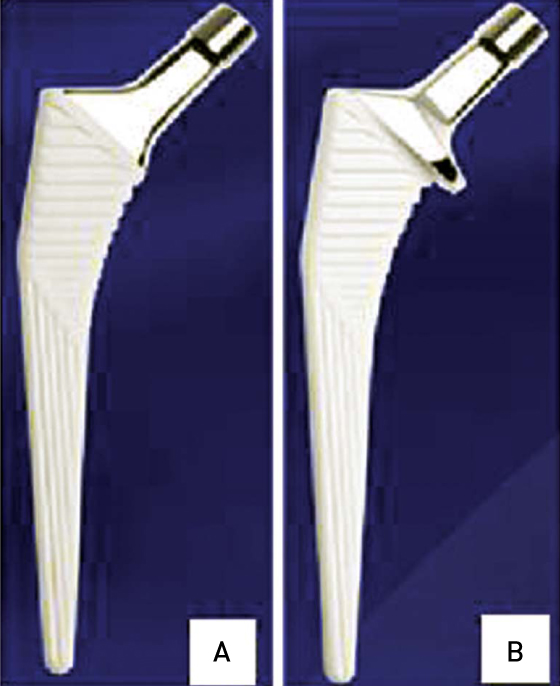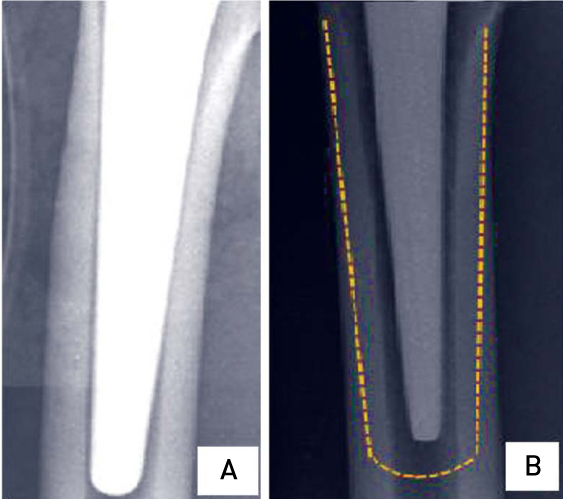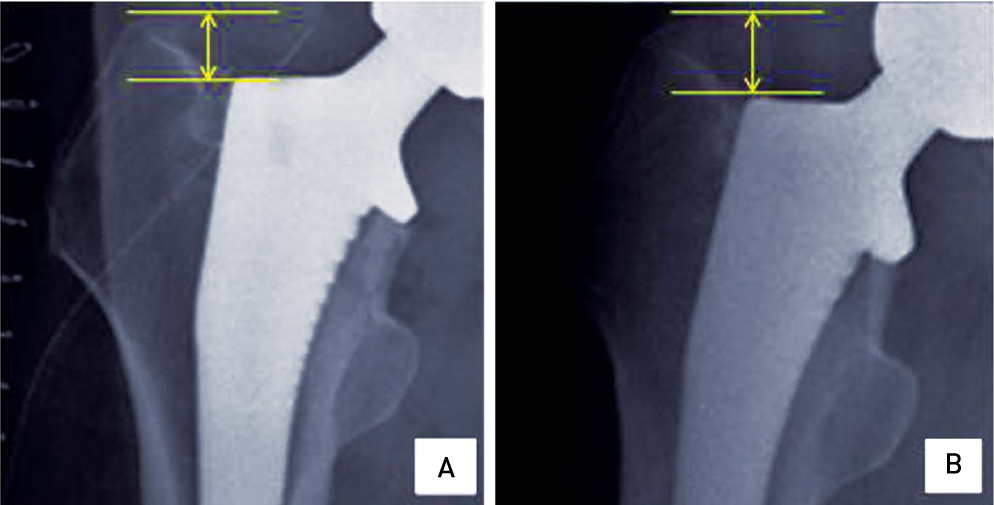Hip Pelvis.
2012 Sep;24(3):186-193. 10.5371/hp.2012.24.3.186.
Short-term Results after Cementless Total Hip Arthroplasty Using a Fully Hydroxyapatite-coated Femoral Stem
- Affiliations
-
- 1Department of Orthopaedic Surgery, School of Medicine, Kangwon National University, Chuncheon, Korea. hkyljh@kangwon.ac.kr
- KMID: 2054131
- DOI: http://doi.org/10.5371/hp.2012.24.3.186
Abstract
- PURPOSE
This study was accomplished to evaluate the clinical & radiological results of cementless total hip arthroplasty using a fully hydroxyapatite-coated femoral stem after follow up of at least, 2 years.
MATERIALS AND METHODS
Thirty one hips in 28 patients, who underwent primary total hip arthroplasty using a fully hydroxyapatite-coated femoral stem between september 2007 and May 2009, were followed up for more than 2 years after surgery. The average age of patients was 67 years old, and the average duration of follow up was 35 months. Preoperative diagnosis was 17 cases of osteonecrosis and 10 cases of femoral neck fracture. Clinical evaluation was done by Harris hip score (HHS). Radiological evaluation was done in terms of stability of components, subsidence of femoral stem and occurrence of osteolysis.
RESULTS
The average of HHS improved from 34.3 preoperatively to 82.6 at final follow-up. Radiologically, fixation by bony ingrowth was 23 cases(74%) and fibrous ingrowth was 8 cases(26%). Subsidence was within 2-4 mm and occurred within 6 weeks in all 5 cases. There were 4 cases of intra-operative femoral fracture, 1 case of superficial infection.
CONCLUSION
Short-term clinical and radiological results of cementless total hip arthroplasty using a fully hydroxyapatite-coated femoral stem were not good enough. Radiologically, bony ingrowth were no more than 74%. Therefore, longer-term follow up would be necessary.
Keyword
MeSH Terms
Figure
Reference
-
1. Capello WN, D'Antonio JA, Jaffe WL, Geesink RG, Manley MT, Feinberg JR. Hydroxyapatite-coated femoral components: 15-year minimum follow up. Clin Orthop Relat Res. 2006. 453:75–80.2. Geesink RG, de Groot K, Klein CP. Bonding of bone to apatite-coated implants. J Bone Joint Surg Br. 1988. 70:17–22.
Article3. Jaffe WL, Scott DF. Total hip arthroplasty with hydroxyapatite-coated prostheses. J Bone Joint Surg Am. 1996. 78:1918–1934.
Article4. Bloebaum RD, Beeks D, Dorr LD, Savory CG, Dupont JA, Hofmann AA. Complications with hydroxyapatite particulate separation in total hip arthroplasty. Clin Orthop Relat Res. 1994. (298):19–26.5. Cook SD, Georgette FS, Skinner HB, Haddad RJ Jr. Fatigue properties of carbon-and porous-coated Ti-6A1-4V alloy. J Biomed Mater Res. 1984. 18:497–512.6. Røkkum M, Reigstad A. Polyethylene wear with an entirely HA-coated total hip replacement: 79 hips followed for 5 years. Acta Orthop Scand. 1998. 69:253–258.
Article7. Morscher EW, Hefti A, Aebi U. Severe osteolysis after third-body wear due to hydroxyapatite particles from acetabular cup coating. J Bone Joint Surg Br. 1998. 80:267–272.
Article8. Stauffer RN. Ten-year follow-up study of total hip replacement. J Bone Joint Surg Am. 1982. 64:983–990.
Article9. Gruen TA, McNeice GM, Amstutz HC. "Modes of failure" of cemented stem-type femoral components: a radiographic analysis of loosening. Clin Orthop Relat Res. 1979. (141):17–27.10. Engh CA, Massin P, Suthers KE. Roentgenographic assessment of the biologic fixation of porous-surfaced femoral components. Clin Orthop Relat Res. 1990. (257):107–128.
Article11. Callaghan JJ, Dysart SH, Savory CG. The uncemented porous-coated anatomic total hip prosthesis. Two-year results of a prospective consecutive series. J Bone Joint Surg Am. 1988. 70:337–346.
Article12. Brooker AF, Bowermen JW, Robinson RA, Riley LH Jr. Ectopic ossification following total hip replacement. Incidence and a method of classification. J Bone Joint Surg Am. 1973. 55:1629–1632.13. Dorr LD, Faugere MC, Mackel AM, Gruen TA, Bognar B, Malluche HH. Structural and cellular assesmenet of bone quality of proximal femur. Bone. 1993. 14:231–242.
Article14. Gulan G, Jurdana H. The canal fill ratio as a factor influencing the aseptic loosening of the Müller-type cemented stem-preliminary report. Coll Antropol. 2007. 31:195–198.15. DeLee JG, Charnley J. Radiological demarcation of cemented sockets in total hip replacement. Clin Orthop Relat Res. 1976. (121):20–32.
Article16. D'Antonio J, McCarthy JC, Bargar WL, et al. Classification of femoral abnormalities in total hip arthroplasty. Clin Orthop Relat Res. 1993. (296):133–139.17. Rothman RH, Hozack WJ, Ranawat A, Moriarty L. Hydroxyapatite-coated femoral stems. A matched-pair analysis of coated and uncoated implants. J Bone Joint Surg Am. 1996. 78:319–324.
Article18. Capello WN. Hydroxyapatite in total hip arthroplasty: five year clinical experience. Orthopedics. 1994. 17:781. 792.
Article19. McNally SA, Shepperd JA, Mann CV, Walczak JP. The results at nine to twelve years of the use of a hydroxyapatite-coated femoral stem. J Bone Joint Surg Br. 2000. 82:378–382.
Article20. Søballe K, Overgarrd S. The current status of hydroxyapatite coating of prostheses. J Bone Joint Surg Br. 1996. 78:689–691.
Article21. Vidalain JP. Twenty-year results of the cementless Corail stem. Int Orthop. 2011. 35:189–194.
Article22. Engh CA, Bobyn JD, Glassman AH. Porous-coated hip replacement. The factors governing bone ingrowth, stress shielding and clinical results. J Bone Joint Surg Br. 1987. 69:45–55.
Article23. Mulliken BD, Bourne RB, Rorabeck CH, Nayak N. A tapered titanium femoral stem inserted without cement in a total hip arthroplasty. Radiographic evaluation and stability. J Bone Joint Surg Am. 1996. 78:1214–1225.
Article24. Dorr Ld, Glousman R, Hoy AL, Vanis R, Chandler R. Treatment of femoral neck fractures with total hip replacement versus cemented and noncemented hemiarthroplasty. J Arthroplasty. 1986. 1:21–28.
Article25. Hallan G, Lie SA, Furnes O, Engesaeter LB, Vollset SE, Havelin LI. Medium- and long-term performance of 11,516 uncemented primary femoral stems from the Norwegian arthroplasty register. J Bone Joint Surg Br. 2007. 89:1574–1580.26. Froimson MI, Garino J, Machenaud A, Vidalain JP. Minimum 10-year results of a tapered, titanium, hydroxyapatite-coated hip stem: an independent review. J Arthroplasty. 2007. 22:1–7.
Article
- Full Text Links
- Actions
-
Cited
- CITED
-
- Close
- Share
- Similar articles
-
- Cementless Total Hip Arthroplasty Using Hydroxyapatite-Coated Femoral stem. - Two-Year Clinical and Radiologic Follow-UP-
- Fracture of Fully-coated Femoral Stem after Primary Total Hip Arthroplasty for Nonunion of Intertrochanteric Fracture: A Case Report
- Clinical and Radiologic Results of Cementless Total Hip Arthroplasty Using Hydroxyapatite - Coated Stem
- Short Term Results of Cementless Total Hip Arthroplasty With a Tapered Femoral Component
- Mid-term Results of Primary Cementless Total Hip Arthroplasty with a Fiber Metal Taper Femoral Component and Trilogy Acetabular Cup







